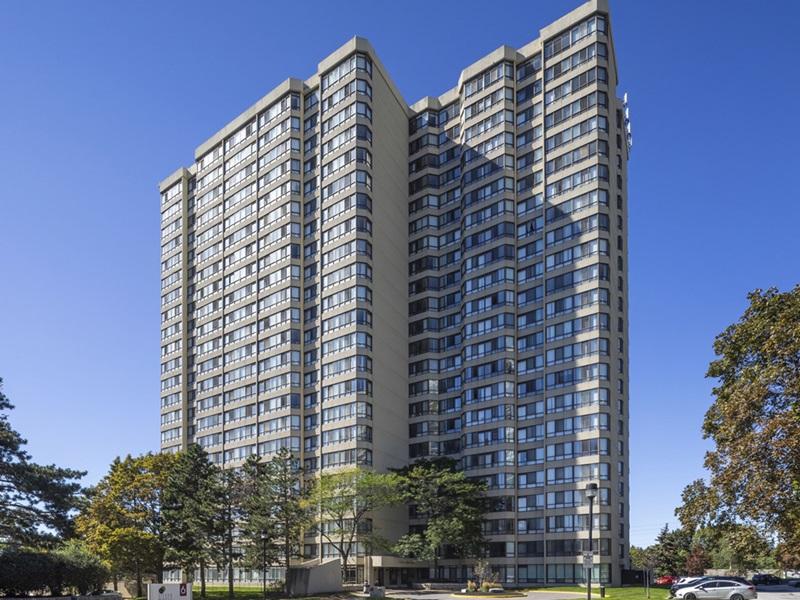
Trinity Development Group and Timbercreek have broken ground on Rideau and Chapel in downtown Ottawa. (Courtesy Trinity)
Trinity Development Group has been laying the groundwork for years to develop several major residential-focused projects in Ottawa. The company and its partners hope they are now about to start reaping the rewards of a 2,700-apartment pipeline in the National Capital.
Trinity and joint venture partner Timbercreek formally broke ground this week on Rideau and Chapel, a two-tower, purpose-built rental apartment development at the eastern edge of Ottawa’s Central Business District. The first tower in the two-phase project contains 315 units and is scheduled to begin occupancy in 2022.
“This project is unique because of the process that we’ve gone through and the twists and turns it has taken,” Trinity’s senior vice-president of development and planning Mathew Laing told RENX.
“Breaking it into two phases was a really big thing for us . . . honing in on one building and getting that right. Hopefully, we do really well on it and then that carries us into Phase II.”
The two 25-storey towers will also contain about 9,500 square feet of ground-floor retail and commercial space, as well as 477 parking spaces, almost all underground. The second tower will contain 318 units and be built behind the first tower, which fronts onto Rideau Street, one of the city’s main downtown thoroughfares.
History of Rideau and Chapel
As Laing noted, Rideau and Chapel has an extended pre-development history. Originally conceived six years ago with a retail and commercial podium anchored by a large grocer, the project was approved by the then-Ontario Municipal Board but did not proceed due to slow market conditions. It has since gone through multiple revisions.
“With the removal of the grocer, we were able to phase the development,” Laing said. “We have a clear-cut line to build Phase I now, and build Phase II when market conditions are right.”
Situated a few hundred metres from one of Ottawa’s new downtown LRT stations, Rideau and Chapel is in an established neighbourhood with no significant rental or condo builds in recent years. Trinity and Timbercreek hope to attract residents from several demographics – students, new residents, young professionals and older couples looking to downsize, to name a few.

The official groundbreaking for Trinity and Timbercreek’s Rideau and Chapel apartment tower. (Courtesy James Park / Trinity)
“This is definitely an area that is underserved by the type of product that we are bringing forward,” Laing said. “With Ottawa now being over a million people, and more people moving into the city, a) there are new people looking for places to live, but b) there is (also) a circular market where people will tend to go to the newest thing.”
The addition of Timbercreek as a partner in the project stems from the two firms’ joint venture in purchasing the Main and Main portfolio of properties and development sites early in 2018.
“That was our first deal together. We formed a really good relationship with them and it just evolved from there,” Laing said.
Both have long track records in Ottawa and know the market well. “It was just natural progression that we do this project together,” Laing added. “It’s rental, it fits within their portfolio, it’s a great kickoff project.”
Other Trinity Ottawa projects
As shovels enter the ground for Rideau and Chapel, Trinity’s founder and executive chairman John Ruddy, president/CEO Fred Waks and its Toronto-based management team are also shepherding three other projects in the city through various pre-development phases.
The largest is Trinity Centre at Bayview Station, a mixed-use, multi-tower development with partners InterRent and PBC Group.
This site effectively gives Trinity book-end developments at the west and east boundaries of the Central Business District. Trinity Centre will sit directly atop the junction of Ottawa’s two LRT lines, once the next phase of the infrastructure project is completed.
A third project, Gladstone and Loretto, is along the soon-to-be-expanded Ottawa Confederation LRT line. It’s proposed as a mixed-use tower with 745 units, plus about 190,000 square feet of office and 18,000 square feet of retail.
This is no coincidence.

Trinity Centre at Bayview Station will be a joint venture involving Trinity, InterRent and PBC Group. (Courtesy Trinity)
“John had us do a study years ago where we really followed the LRT line and we identified all of the proposed stops. Then we were looking for land around those,” said Laing.
“So we have our 900 Albert project, we have our Gladstone and Loretto project, each at a node, a new station. That was really the intention behind that. It was just literally following the transit.
“We’ve looked at other locations as well, (but) nothing that we are bringing forward at this time.”
The other development in Trinity’s current pipeline is Richmond and Island Park, more of a boutique-style development which would feature ground-floor retail in a mid-rise building with 40 residential units.
What’s driving the urge to build
900 Albert features three towers and an expansive, multi-level podium. It will also be built in phases, and is planned to contain 1,300 housing units, about 85,000 square feet of retail and 500,000 square feet of office space.
“900 Albert is a project that’s been around for, I would say, seven years and it really picked up steam in the last year-and-a-half as well,” Laing said. “We pushed forward and got the zoning approval; now we’re just working through (the) site plan and we have a construction schedule being put together for that one as well.”
The key drivers to all the projects have been Ottawa’s population growth and growing economy. The city has just surpassed one million residents, has an apartment vacancy rate south of two per cent and its office and industrial vacancy rates have been steadily declining for several years.
“I’ve attended several forums in the past year-and-a-half and there’s been a constant discussion about how well the Ottawa market is doing,” Laing said.
Trinity’s projects are not the only significant developments across the city. RioCan REIT and Killam Apartment REIT are developing multiple rental apartment towers just a few kilometres east of the downtown, along the LRT. The massive Zibi project is underway west of the core and other developers have major residential-based developments at various stages.
Despite its ongoing growth, though, could Ottawa suddenly face an overbuild situation?
“That’s always a concern,” Laing admitted. “The term I like to use is conservatively aggressive. You want to have the principals in place where you don’t end up in a situation where you over-assumed a market. We’re really focusing in on that and that’s why a lot of these projects have phasing.
“Even 900 Albert has a phasing plan, Gladstone has as well and Rideau obviously.
“If we were super-aggressive, it’d be ‘We’re building it all.’ That probably wouldn’t be the right thing to do. Through phasing it, (we’re) giving ourselves the opportunity to continue to test those markets and to really gather all the information and make the right decisions based on that.”
RELATED ARTICLES:
* Supply imbalance persists, despite Ottawa multires boom







